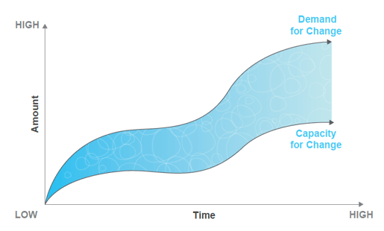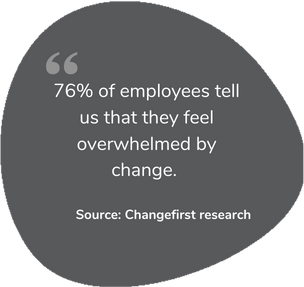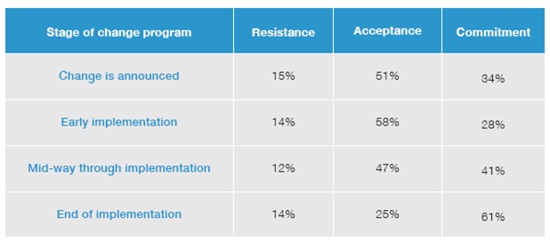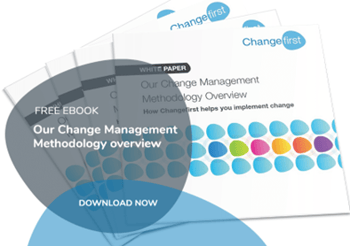It is a given – not only that organisations need to deliver more business-critical change solutions - but also true that change fatigue and burnout is on the increase.

73% of employees tell us that they are overwhelmed by Change – particularly as major organisational change often requires people to also make personal changes. And the demand for Change very often exceeds people’s capacity to adapt and deliver it.

By helping people to adapt – faster and more sustainably – to change you:
- Reduce resistance to change
- Help sustain good personal performance during change disruption

And helping people adapt to Change starts with equipping middle and front-line managers – who have a pivotal role to play in helping their teams engage with Change – with the skills and tools to be effective local sponsors. Leading their teams through Change.
Principle 1: Decide how much commitment you need (or have the appetite for)
First a definition: Commitment occurs when an individual takes personal responsibility for making a Change happen and for sustaining their effort to delivery promised outcomes. However, when we hear people talk about Commitment, they sometimes seem to be describing Acceptance. In fact, they are using much more passive descriptions which can be synonymous with the word ‘compliance’

And the reality is that different Changes require different levels of commitment.
Acceptance may be enough for low level Changes but it certainly won’t be enough to ensure you transform your enterprise.
Commitment requires far more effort to build, will take longer and be more expensive to achieve than Acceptance.
This in turn means that people can be slow to adapt since the sheer scope and magnitude of Change can be overwhelming.
This means that:
- Change plans need to reflect the level of Commitment you require.
- A plan to build and sustain Commitment will be a more detailed undertaking. And will require middle and front-line managers to show Commitment - and have the know-how - to help push their teams along the same path.
Principle 2: Engage local – middle and front-line managers early
People can be logical, emotional, uncertain, controlling, kind and adversarial. All in the space of five minutes.
Employees are usually signed-up members of the human race. In other words, they will act as people tend to act – with deep-seated habits and fears associated with a loss of control. Yet the mindset of many senior sponsors is that people will engage and commit if the argument is compelling enough.
Unfortunately, it rarely works like that. Even if people are positive and energised by early messages from senior leaders, for example -when they first hear the case for Change. It is the hard graft of committed ‘local’ leaders that can:
- turn early energy into a real connection and commitment to change
- identify and manage resistance and relapses that threaten early commitment
Principle 3: Expect people to go backwards as well as forwards
Change and the stages of change are not linear.
People don’t neatly trot through the stages to acceptance. Often, they might arrive at acceptance and relapse fall back to anger. They may move forward and then appear to lose their way and regress to denial.
Prochaska, Norcross and Diclemente, in their book Change for Good, refer to this process as the “spiral model” of Change. They suggest that relapses are the rule rather than the exception when it comes to Change. Those affected by Change can often feel as though they have failed and that all their efforts have been in vain.
The good news is that with focused Change Management application on major organisational Changes, commitment can be built. In fact, we have organisations who are using our proven methodology and approach who are reporting at the ‘end of an initiative’ that they are getting a commitment level of 60% plus.

Source: Changefirst Initiative Risk Assessment 2022 (8,830 responses from 82 organisations)
The challenge however, and the business case for an ongoing and data-driven approach to Change planning and deployment, is that only 24% of employees said they were still committed 9 – 12 months after a change was declared as ‘implemented’.
-1.png?width=341&height=313&name=3%20Principles%20for%20helping%20people%20adapt%20to%20change%20(1)-1.png)
Could this be a hard core of engaged employees who will ‘automatically’ commit to most organisational ideas?
So, what are we missing and where should we focus to close the Change Gap between the 24% and the 60% + group? We believe the answer lies in tracking and managing the risk associated with commitment to change.
|
|
Measuring risks around Commitment Changefirst's initiative Risk Assessment is one of 9 powerful multi-lingual behaviour & risk assessment tools with built-in mitigation suggestions.
|





Leave a comment